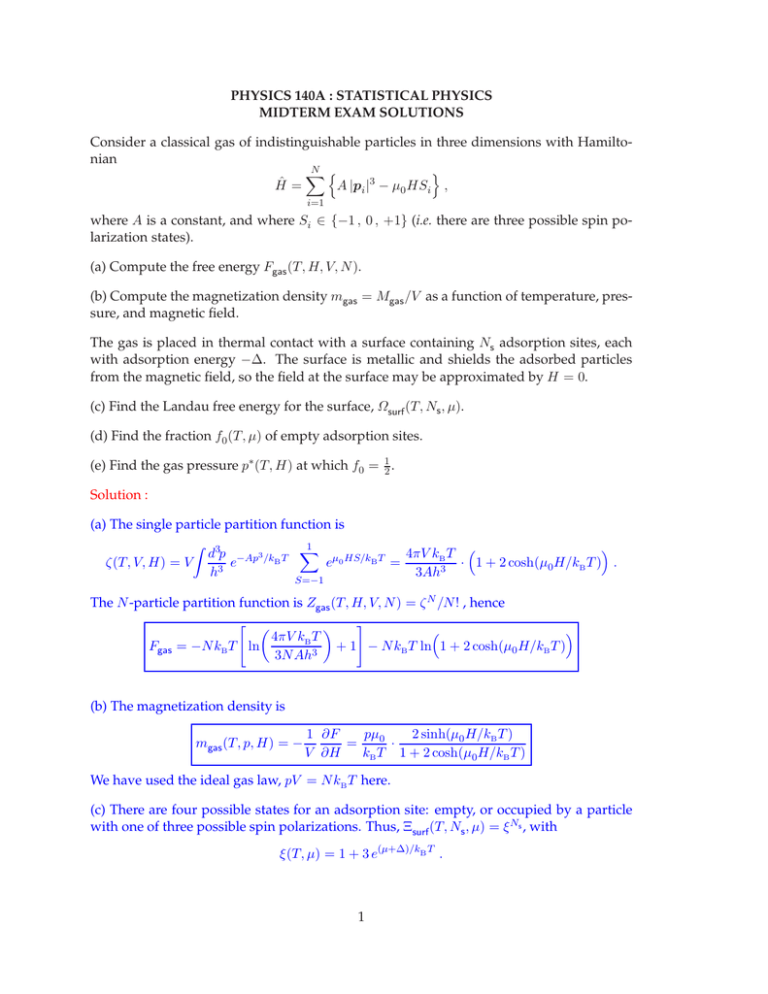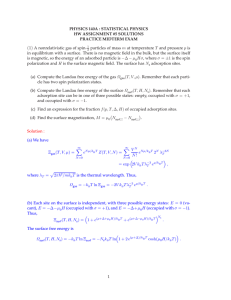PHYSICS 140A : STATISTICAL PHYSICS MIDTERM EXAM SOLUTIONS nian
advertisement

PHYSICS 140A : STATISTICAL PHYSICS
MIDTERM EXAM SOLUTIONS
Consider a classical gas of indistinguishable particles in three dimensions with Hamiltonian
N n
o
X
A |pi |3 − µ0 HSi ,
Ĥ =
i=1
where A is a constant, and where Si ∈ {−1 , 0 , +1} (i.e. there are three possible spin polarization states).
(a) Compute the free energy Fgas (T, H, V, N ).
(b) Compute the magnetization density mgas = Mgas /V as a function of temperature, pressure, and magnetic field.
The gas is placed in thermal contact with a surface containing Ns adsorption sites, each
with adsorption energy −∆. The surface is metallic and shields the adsorbed particles
from the magnetic field, so the field at the surface may be approximated by H = 0.
(c) Find the Landau free energy for the surface, Ωsurf (T, Ns , µ).
(d) Find the fraction f0 (T, µ) of empty adsorption sites.
(e) Find the gas pressure p∗ (T, H) at which f0 = 12 .
Solution :
(a) The single particle partition function is
Z 3
1
d p −Ap3 /k T X µ0 HS/k T
4πV kB T B
B
ζ(T, V, H) = V
e
=
e
· 1 + 2 cosh(µ0 H/kB T ) .
h3
3Ah3
S=−1
The N -particle partition function is Zgas (T, H, V, N ) = ζ N /N ! , hence
" #
4πV kB T
Fgas = −N kB T ln
+
1
−
N
k
T
ln
1
+
2
cosh(µ
H/k
T
)
B
0
B
3N Ah3
(b) The magnetization density is
mgas (T, p, H) = −
pµ0
2 sinh(µ0 H/kB T )
1 ∂F
=
·
V ∂H
kB T 1 + 2 cosh(µ0 H/kB T )
We have used the ideal gas law, pV = N kB T here.
(c) There are four possible states for an adsorption site: empty, or occupied by a particle
with one of three possible spin polarizations. Thus, Ξsurf (T, Ns , µ) = ξ Ns , with
ξ(T, µ) = 1 + 3 e(µ+∆)/kB T .
1
Thus,
Ωsurf (T, Ns , µ) = −Ns kB T ln 1 + 3 e(µ+∆)/kB T
(d) The fraction of empty adsorption sites is 1/ξ, i.e.
f0 (T, µ) =
1
1+
3 e(µ+∆)/kB T
(e) Setting f0 = 12 , we obtain the equation 3 e(µ+∆)/kB T = 1, or
eµ/kB T =
1
3
e−∆/kB T .
We now need the fugacity z = eµ/kB T in terms of p, T , and H. To this end, we compute the
Landau free energy of the gas,
Ωgas = −pV = −kB T ζ eµ/kB T .
Thus,
p∗ (T, H) =
kB T ζ µ/k T
4π(kB T )2 e B =
·
1
+
2
cosh(µ
H/k
T
)
e−∆/kB T
0
B
V
9Ah3
2






